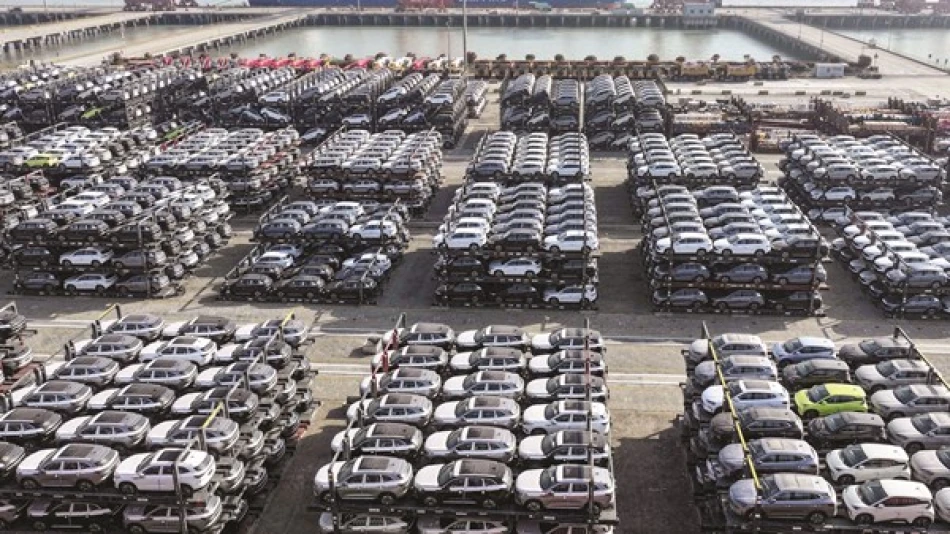
China's Electric Vehicles Charge Ahead in the Global Automotive Market Race
China's Electric Vehicle Empire: How BYD Dethroned Tesla and Reshaped Global Auto Markets
China has fundamentally transformed the global automotive landscape, with its electric vehicle manufacturers now dominating both domestic and international markets. Led by BYD's historic victory over Tesla as the world's largest EV producer in 2024, Chinese automakers are leveraging massive government support, advanced battery technology, and aggressive pricing to capture market share worldwide—forcing Western nations to impose protective tariffs while scrambling to defend their own industries.
The Numbers Behind China's EV Dominance
China's automotive ascendancy is built on staggering production volumes and strategic investment. The country sold a record 31.4 million vehicles domestically in 2024, with electric vehicles comprising 41% of total sales. This surge helped China surpass Japan in 2023 as the world's largest car exporter, marking a historic shift in global automotive power.
BYD alone has produced over one million vehicles annually for three consecutive years, while the broader Chinese EV ecosystem includes established players like Geely and SAIC Motor alongside ambitious startups such as Li Auto and NIO. Battery giant CATL serves as the critical supplier powering this entire network, giving China vertical integration advantages that competitors struggle to match.
The $230 Billion R&D Investment
Between 2009 and 2023, China invested approximately $230 billion in automotive research and development—a commitment that dwarfs similar efforts in Europe and North America. This massive funding, combined with tax exemptions, subsidies, and favorable financing, has created an ecosystem where Chinese manufacturers can price their vehicles 20-30% below Western competitors while maintaining profitability.
Market Saturation Drives Global Expansion
China's domestic EV market has reached near-saturation levels, pushing manufacturers to aggressively pursue international expansion. This mirrors the historical pattern of Japanese automakers in the 1970s and South Korean brands in the 1990s, but with unprecedented speed and scale.
Chinese EVs already represent 10% of total vehicle sales in the United Kingdom as of June 2024, demonstrating rapid consumer acceptance in mature markets. Industry experts project China will produce 36 million vehicles annually by 2030—representing four out of every ten cars manufactured globally—with exports reaching 9 million units compared to just one million in 2020.
Western Response: Tariffs and Trade Tensions
The United States and European Union have responded to Chinese EV dominance with protective tariffs, recognizing the existential threat to their domestic automotive industries. The European Automobile Manufacturers' Association, representing 16 major companies including Volvo, Volkswagen, BMW, Renault, and Stellantis, has lobbied Brussels for stronger competitive measures.
These tariffs reflect broader concerns about China's state-supported industrial policy, which Western governments argue creates unfair competitive advantages. However, such measures may only slow rather than stop Chinese expansion, particularly in emerging markets where price sensitivity remains paramount.
Competitive Advantages Beyond Subsidies
China's EV success stems from multiple structural advantages beyond government support. Lower labor costs, a weakened yuan that boosts export competitiveness, advanced technical innovations, and a robust battery supply chain create a formidable combination. Chinese manufacturers have also demonstrated superior agility in product development and market responsiveness compared to traditional automakers.
Market Reality: Not All Winners in China's EV Boom
Despite the sector's overall success, the Chinese EV market's overcrowded nature means not all companies are thriving. Many startups struggle to achieve profitability in an increasingly saturated domestic market, suggesting consolidation is inevitable. This mirrors the early automotive industry's evolution, where hundreds of manufacturers eventually consolidated into a handful of major players.
The challenge for Chinese EV companies will be maintaining growth momentum as they transition from a government-supported domestic market to competitive international environments where they face established dealer networks, consumer preferences, and regulatory hurdles. Success in this next phase will determine whether China's EV revolution represents a temporary market disruption or a permanent reshaping of the global automotive industry.
 Layla Al Mansoori
Layla Al Mansoori







